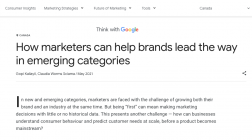How marketers can help brands lead the way in emerging categories
In new and emerging categories, marketers are faced with the challenge of growing both their brand and an industry at the same time. But being “first” can mean making marketing decisions with little or no historical data. This presents another challenge — how can businesses understand consumer behaviour and predict customer needs at scale, before a product becomes mainstream?
The auto industry is a great example of this. It’s currently being transformed by the emergence of electric vehicles (EVs). While the EV market has been slow to take off, in Canada search interest in electric vehicles has steadily increased over recent years. KPMG in Canada research found that 70% of Canadians who plan to buy a new car within the next five years are likely to buy an electric one.
For years, a small number of brands have been largely associated with EVs, but there are now more than a dozen EV launches expected in Canada this year, and even more expected by 2025. With more consumer interest and competitors emerging in the space, it creates opportunity for new brands to make a name within the growing category.
Marketers are in a unique position to help brands “move first” by digging into a range of consumer data and signals to find market opportunities, understand the needs and wants of potential customers, and help ensure campaigns are optimized to reach them. Here are some ways marketers can help brands establish an early presence in growing categories.
Find the early adopters, the close adopters, those on the fence, the masses and the rejectors — then create personalized campaign strategies to meet each one.
Understand who the customer is — or who it could be
In emerging categories, it’s not just about knowing who the current customers are — it’s also about reaching customers that could be. Find the early adopters, the close adopters, those on the fence, the masses and the rejectors — then create personalized campaign strategies to meet each one. Look to first-party data, search and video analytics, and data from adjacent categories to help identify audience segments and potential leads.
Artificial intelligence (AI) and machine-learning solutions, such as Google Cloud predictive analytics modelling, can help find patterns and future opportunities. It analyzes both current and historical data to make predictions about the future.
Adapt messaging to address potential sales barriers
With these insights, craft personalized and automated campaign strategies that will resonate. Try to identify the reasons why people may or may not buy an innovative product, then address those potential barriers through proactive messaging and campaigns. Clearly convey the value proposition, such as aspirational benefits and impacts, not just things like costs.
For example, electric car sales have moved slowly for years, but addressing barriers and opportunities like cost or supply, can help educate consumers, create a compelling value proposition, and move the category along. Emphasizing features like a large charging network, or exploring ways to advertise bundles of products and services helps emphasize the overall experience.
Advertise where curious consumers are
When people are purchasing new and emerging products, they can’t rely on previous experiences or word-of-mouth. Use innovative and personalized approaches, such as digital campaigns, to reach and educate prospective customers while they’re researching online.
Five years ago, Asbury Automotive Group began noticing that most of its customers were doing significant online research before buying a car. The team shifted to a data-driven approach based on consumer insights and expectations. They increased their online advertising investment by 20X and saw their cost-per-sale decline more than 75%. They are now selling more cars online, and continue to test tactics usually reserved for e-commerce providers, like Google Shopping Ads.
Research shows the majority of people considering buying an electric vehicle or plug-in-hybrid-vehicle are spending longer than a month researching before their purchase.1 They’re also using more online sources than the average new vehicle buyer during this research journey — looking at an average of seven online resources and two offline resources. 2
Let data and automation be a guide to help you learn and iterate quickly.
Video has also emerged as an important tool for auto research and discovery. In Brazil, new car buyers are 1.5X more likely to use YouTube in the car-buying process than traditional car buyers.3 Focusing on areas and customer segments that are actively considering will be critical to reach scale quickly, and to create a network of advocates.
Measure success to inform future campaigns
It’s important to work with your team and partners to align on what success looks like and the intended outcomes. This will help ensure teams are on the same page.
Be sure to measure campaign results and marketing efforts, to inform ongoing strategies. Identifying wins and misses will help to understand customers, but also help spot opportunities as the category evolves and new customer needs emerge.
Marketing new and emerging products can seem daunting, but let data and automation be a guide to help you learn and iterate quickly. A personalized approach that reaches curious consumers during the research and discovery phase can help brands connect with potential customers and establish their name, while growing a category.
Gopi Kallayil, Claudia Worms Sciama / May 2021
